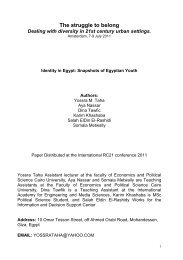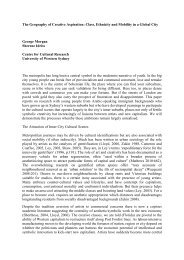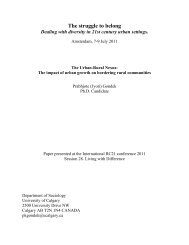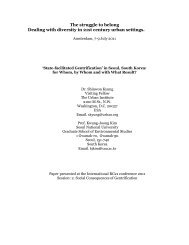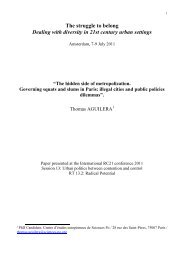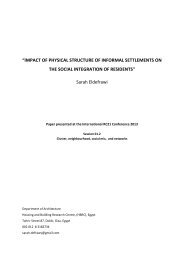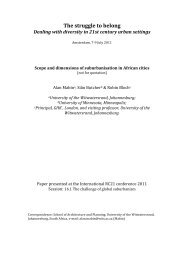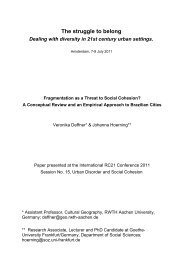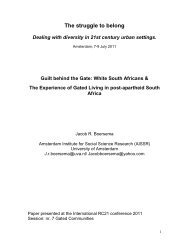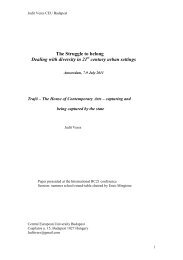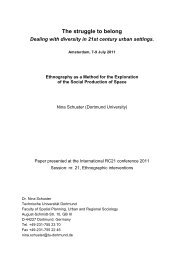Gentrification in the mill land areas of Mumbai city - RC21 ORG ...
Gentrification in the mill land areas of Mumbai city - RC21 ORG ...
Gentrification in the mill land areas of Mumbai city - RC21 ORG ...
You also want an ePaper? Increase the reach of your titles
YUMPU automatically turns print PDFs into web optimized ePapers that Google loves.
always receives mixed op<strong>in</strong>ion from <strong>the</strong> policy makers, researchers, urban sociologists and<br />
planners. For some gentrification helps to rega<strong>in</strong> money by revitalisation <strong>of</strong> <strong>areas</strong> whereas for<br />
o<strong>the</strong>rs it is a huge social cost <strong>in</strong>curred <strong>in</strong> an area <strong>in</strong> order to rejuvenate, <strong>the</strong>reby caus<strong>in</strong>g large<br />
displacement <strong>of</strong> population and little or no ga<strong>in</strong> for <strong>the</strong> <strong>city</strong> (Atk<strong>in</strong>son, 2004).<br />
<strong>Gentrification</strong> does not follow any discreet process; it <strong>of</strong>ten acts <strong>in</strong> <strong>the</strong> comb<strong>in</strong>ation with<br />
many. Therefore whe<strong>the</strong>r it is <strong>in</strong> <strong>the</strong> form <strong>of</strong> displacement <strong>of</strong> population from <strong>the</strong> <strong>in</strong>ner <strong>city</strong><br />
due to <strong>the</strong> process <strong>of</strong> de<strong>in</strong>dustrialisation, displacement due to racial conflict <strong>in</strong> places like<br />
Harlem, upcom<strong>in</strong>g cafes, bars nightclubs and art galleries <strong>in</strong> SoHo <strong>of</strong> New York and<br />
formation <strong>of</strong> new cultural capital eras<strong>in</strong>g <strong>the</strong> old or movement <strong>of</strong> people back to <strong>the</strong> <strong>city</strong> from<br />
<strong>the</strong> suburbs popularised as ‘revanchism’ <strong>in</strong> <strong>the</strong> Society Hill Philadelphia or <strong>in</strong> Wash<strong>in</strong>gton<br />
DC(Smith,1996:52) <strong>the</strong> various discourses <strong>of</strong> gentrification occurs <strong>in</strong> various stages.<br />
When we compare <strong>the</strong> develop<strong>in</strong>g world with developed world it is found that <strong>the</strong>re is always<br />
a difference between <strong>the</strong> first world cities and <strong>the</strong> third world cities round <strong>the</strong> world (Deb,<br />
2006). Specifically, <strong>in</strong> India <strong>the</strong> contrast is very prom<strong>in</strong>ent because India once be<strong>in</strong>g a<br />
colonial country had <strong>the</strong> centralised adm<strong>in</strong>istrative system. Therefore <strong>the</strong> role <strong>of</strong> <strong>the</strong> state is<br />
very important here. Moreover a large number <strong>of</strong> population <strong>in</strong> India is under <strong>the</strong> below<br />
poverty l<strong>in</strong>e and <strong>the</strong> technological development is low as compared to o<strong>the</strong>r countries. All<br />
<strong>the</strong>se drawbacks compel government to form different policies for its growth and<br />
development. To study <strong>the</strong> growth and development <strong>of</strong> Indian cities Marxist approach seems<br />
to be relevant as Deb (2006: 347) stated that, “presently cities <strong>in</strong> India are grow<strong>in</strong>g accord<strong>in</strong>g<br />
<strong>the</strong> logic <strong>of</strong> capitalist mode <strong>of</strong> accumulation <strong>of</strong> surplus. The urban <strong>land</strong> use is <strong>the</strong>refore<br />
primarily structured by a rent maximis<strong>in</strong>g <strong>land</strong> market and <strong>the</strong> geographical pattern that<br />
develops is <strong>of</strong> a dense commercial core, a tendency for ever widen<strong>in</strong>g peripheral scatter<strong>in</strong>g <strong>of</strong><br />
<strong>in</strong>dustries and <strong>the</strong> appearance <strong>of</strong> socially segregated residential neighbourhoods”. In <strong>the</strong><br />
Marxist approach <strong>the</strong> accumulation <strong>of</strong> capital takes place <strong>in</strong> <strong>the</strong> production sphere i.e.<br />
<strong>in</strong>dustries, gets circulated <strong>in</strong> <strong>the</strong> circulation sphere by roads, highways, commerce, bank<strong>in</strong>g<br />
etc and goes to <strong>the</strong> reproduction sphere which <strong>in</strong> this case is hous<strong>in</strong>g for <strong>the</strong> labourers near<br />
<strong>the</strong>ir work<strong>in</strong>g place. Due to pr<strong>of</strong>it motive approach <strong>of</strong> <strong>the</strong> capitalist <strong>the</strong>re are many sectors<br />
where <strong>the</strong> private <strong>in</strong>vestors do not f<strong>in</strong>d any <strong>in</strong>terest to <strong>in</strong>terfere. State’s <strong>in</strong>tervention at that<br />
po<strong>in</strong>t <strong>of</strong> time becomes very important. Any breakdown <strong>in</strong> <strong>the</strong> equilibrium among <strong>the</strong> three<br />
spheres can lead to crises. Like any o<strong>the</strong>r cities <strong>of</strong> India, <strong>in</strong> <strong>Mumbai</strong> <strong>the</strong> State <strong>of</strong>ten acts as an<br />
agent <strong>of</strong> <strong>the</strong> capitalist class because it is operat<strong>in</strong>g under <strong>the</strong> capitalist system. At this po<strong>in</strong>t I




